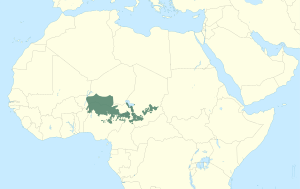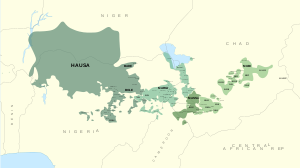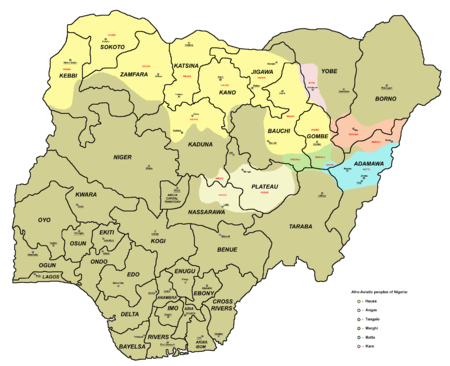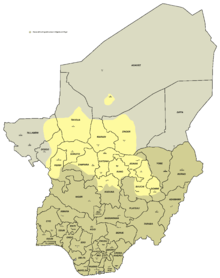Chadic languages
The Chadic languages form a branch of the Afroasiatic language family. They are spoken in parts of the Sahel. They include 150 languages spoken across northern Nigeria, southern Niger, southern Chad, Central African Republic and northern Cameroon. The most widely spoken Chadic language is Hausa, a lingua franca of much of inland Eastern West Africa.
| Chadic | |
|---|---|
| Geographic distribution | Nigeria, Niger, Chad, Central African Republic, Cameroon |
| Linguistic classification | Afro-Asiatic
|
| Subdivisions | |
| ISO 639-5 | cdc |
| Glottolog | chad1250[1] |
 Map of the distribution of the Chadic languages within Africa | |
 Detailed map of the of the distribution of Chadic languages in Western and Central Africa | |
Composition
Newman (1977) classified the languages into the four groups which have been accepted in all subsequent literature. Further subbranching, however, has not been as robust; Blench (2006), for example, only accepts the A/B bifurcation of East Chadic.[2] Kujargé has been added from Blench (2008), who suggests Kujargé may have split off before the breakup of Proto-Chadic and then subsequently became influenced by East Chadic.[3] Subsequent work by Lovestrand argues strongly that Kujarge is a valid member of East Chadic. The placing of Luri as a primary split of West Chadic is erroneous. Caron (2004) shows that this language is South Bauchi and part of the Polci cluster.
- West Chadic. Two branches, which include
- (A) the Hausa, Ron, Bole, and Angas languages; and
- (B) the Bade, Warji, and Zaar languages.
- Biu–Mandara (Central Chadic). Three branches, which include
- (A) the Bura, Kamwe, and Bata languages, among other groups;
- (B) the Buduma and Musgu languages; and
- (C) Gidar
- East Chadic. Two branches, which include

Origin


Several modern genetic studies of Chadic speaking groups in the northern Cameroon region have observed high frequencies of the Y-Chromosome Haplogroup R1b in these populations (exclusively, of R1b's R1b-V88-Y7771[4] variant). This paternal marker is common in parts of West Eurasia, but otherwise rare in Africa. Cruciani et al. (2010) thus propose that the Proto-Chadic speakers during the mid-Holocene (~7,000 years ago) migrated from the Levant to the Central Sahara, and from there settled in the Lake Chad Basin.[5] However, a 2018 study by Daniel Shriner agrues that the haplogroup R1 is associated with (Baggarization) and found no evidence of ancient Eurasian gene flow. (https://pubmed.ncbi.nlm.nih.gov/30259956/)
Loanwords
Chadic languages contain many Nilo-Saharan loanwords from either the Songhay or Maban branches, pointing to early contact between Chadic and Nilo-Saharan speakers as Chadic was migrating west.[6]
Although Adamawa languages are spoken adjacently to Chadic languages, interaction between Chadic and Adamawa is limited.[7]
Comparative vocabulary
Sample basic vocabulary in different Chadic branches listed in order from west to east, with Proto-Cushitic also given for comparison:
| Language | eye | ear | nose | tooth | tongue | mouth | blood | bone | tree | water | eat | name |
|---|---|---|---|---|---|---|---|---|---|---|---|---|
| Proto-Chadic[8] | *ydn | *km/*ɬm | *ntn | *s₃n; *ƙ-d | *ls₃- | *bk | *br | *ƙs₃ | *ymn | *hrɗ (hard); *twy (soft) | *s₃m | |
| Hausa[9] | ido | kunne | hanci | haƙori | harshe | baki | jini | ƙashi | itaci; bishiya | ruwa | ci | suna |
| Proto-Ron[10] | *kumu | **atin | *haŋgor | *liʃ | *fo | ɟɑ̄lɑ̄, tɾɔ̃̄ | *kaʃ | *sum | ||||
| Polci[11] | yiir | kəəm | cin | shen | haƙori | bii | buran; bəran | gooloo | pət | maa | ci | suŋ |
| Proto-Central Chadic[12] | *hadaj; *tsɨʸ | *ɬɨmɨɗʸ | *hʷɨtsɨnʸ | *ɬɨɗɨnʸ | *ɗɨrɨnɨhʸ; *ɣanaɗʸ; *naɬɨj | *maj | *ɗiɬ; *kɨrakaɬʸ | *hʷɨp | *ɗɨjɨm | *zɨm | *ɬɨmɨɗʸ | |
| Proto-Masa[13] | *ir | *hum | *cin | *s- | *si | *vun | *vuzur | *sok | *gu | *mb- | *ti | *sem |
| Kujarge[14] | kunɟu | kumayo ~ kime | kaata | kiya | aliŋati | apa | ɪbɪrí | (kaɟeɟa), kàyɛ́ya | kaʃíè | ʃia | (tona), tuye [imp. sg.]; tuwona [imp. pl.] | rúwà |
| Proto-Cushitic[15] | *ʔil- | *?isŋʷ- | *ʔiɬkʷ- | *caanrab- | *ʔaf-/*yaf- | *mikʷ’-; *moc’- | *-aħm-/*-uħm-; *ɬaam- | *sim-/*sum- |
Bibliography
- Caron, Bernard 2004. Le Luri: quelques notes sur une langue tchadique du Nigeria. In: Pascal Boyeldieu & Pierre Nougayrol (eds.), Langues et Cultures: Terrains d’Afrique. Hommages à France Cloarec-Heiss (Afrique et Langage 7). 193-201. Louvain-Paris: Peeters.
- Lukas, Johannes (1936) 'The linguistic situation in the Lake Chad area in Central Africa.' Africa, 9, 332–349.
- Lukas, Johannes. Zentralsudanische Studien, Hamburg 1937;
- Newman, Paul and Ma, Roxana (1966) 'Comparative Chadic: phonology and lexicon.' Journal of African Languages, 5, 218–251.
- Newman, Paul (1977) 'Chadic classification and reconstructions.' Afroasiatic Linguistics 5, 1, 1–42.
- Newman, Paul (1978) 'Chado-Hamitic 'adieu': new thoughts on Chadic language classification', in Fronzaroli, Pelio (ed.), Atti del Secondo Congresso Internazionale di Linguistica Camito-Semitica. Florence: Instituto de Linguistica e di Lingue Orientali, Università di Firenze, 389–397.
- Newman, Paul (1980) The Classification of Chadic within Afroasiatic. Leiden: Universitaire Pers Leiden.
- Herrmann Jungraithmayr, Kiyoshi Shimizu: Chadic lexical roots. Reimer, Berlin 1981.
- Herrmann Jungraithmayr, Dymitr Ibriszimow: Chadic lexical roots. 2 volumes. Reimer, Berlin 1994
- Schuh, Russell (2003) 'Chadic overview', in M. Lionel Bender, Gabor Takacs, and David L. Appleyard (eds.), Selected Comparative-Historical Afrasian Linguistic Studies in Memory of Igor M. Diakonoff, LINCOM Europa, 55–60.
- Data sets
- Robert Forkel, & Tiago Tresoldi. (2019). lexibank/kraftchadic: Chadic Wordlists (Version v3.0) [Data set]. Zenodo. doi:10.5281/zenodo.3534953
References
- Hammarström, Harald; Forkel, Robert; Haspelmath, Martin, eds. (2017). "Chadic". Glottolog 3.0. Jena, Germany: Max Planck Institute for the Science of Human History.
- Blench, 2006. The Afro-Asiatic Languages: Classification and Reference List (ms)
- Blench, Roger. 2008. Links between Cushitic, Omotic, Chadic and the position of Kujarge. 5th International Conference of Cushitic and Omotic languages.
- https://yfull.com/tree/R-Y7771/
- Cruciani, F; Trombetta, B; Sellitto, D; Massaia, A; Destro-Bisol, G; Watson, E; Beraud Colomb, E; Dugoujon, JM; Moral, P; Scozzari, R (2010). "Human Y chromosome haplogroup R-V88: a paternal genetic record of early mid Holocene trans-Saharan connections and the spread of Chadic languages". European Journal of Human Genetics. 18 (7): 800–7. doi:10.1038/ejhg.2009.231. PMC 2987365. PMID 20051990.
- Ehret, Christopher. 2006. The Nilo-Saharan background of Chadic Archived 2019-08-01 at the Wayback Machine. In P. Newman and L. M. Hyman (eds), West African linguistics: studies in honor of Russell G. Schuh, pp. 56-66. Studies in African Linguistics Suppl. 11. Columbus: Ohio University Press.
- Blench, Roger. 2012. Linguistic evidence for the chronological stratification of populations South of Lake Chad. Presentation for Mega-Tchad Colloquium in Naples, September 13–15, 2012.
- Jungraithmayr, Herrmann; Ibriszimow, Dymitr (1994). Chadic Lexical Roots: Tentative reconstruction, grading, distribution and comments. (Sprache und Oralität in Afrika; 20), volume I, Berlin: Dietrich Reimer Verlag.
- Cosper, Ronald. 2015. Hausa dictionary. In: Key, Mary Ritchie & Comrie, Bernard (eds.) The Intercontinental Dictionary Series. Leipzig: Max Planck Institute for Evolutionary Anthropology. (Available online at http://ids.clld.org/contributions/220, Accessed on 2019-12-31.)
- Blench, Roger. no date. Ron comparative wordlist.
- Cosper, Ronald. 2015. Polci dictionary. In: Key, Mary Ritchie & Comrie, Bernard (eds.) The Intercontinental Dictionary Series. Leipzig: Max Planck Institute for Evolutionary Anthropology. (Available online at http://ids.clld.org/contributions/221, Accessed on 2019-12-31.)
- Gravina, Richard. 2014. Proto-Central Chadic Lexicon. Webonary.
- Shryock, Aaron. 1997. The classification of the Masa group of languages. Studies in African Linguistics 26(1): 29‒62.
- Doornbos, Paul. 1981. Field notes on Kujarge, language metadata, 200-word list plus numerals and pronouns.
- Ehret, Christopher. 1987. Proto-Cushitic reconstruction. In Sprache und Geschichte in Afrika 8: 7-180. University of Cologne.